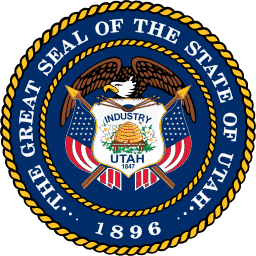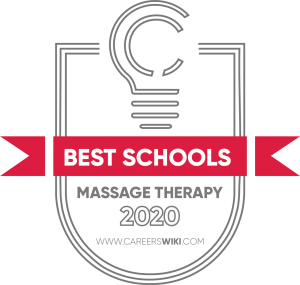…
There are seven massage therapy schools in Utah. Some focus only on MT, while others are beauty institutes or colleges with programs in multiple fields.
Earning an MT certificate typically takes less than one year of full-time study. Curricula feature lectures and lab classes. Students receive practical experience at on-campus clinics, community facilities, and private businesses.
Employment opportunities for Utah MTs are expanding much more rapidly than the national average. Officials expect 310 annual job openings during the decade ending in 2026.
Follow the link to find a massage school or a program in another state.

This government agency administers and enforces laws concerning the licensure and regulation of certain occupations and professions.
DOPL’s two “primary functions” are licensing and investigations. Eight bureaus, each assigned to oversee designated occupations, ensure that professionals earn licenses and renew them. One bureau establishes standards for massage therapy educational programs.
The division’s Investigators look into allegations of illegal or unprofessional conduct. They assess fines and take other disciplinary actions, such as license suspensions and revocations, when warranted.
The state Department of Commerce appoints the DOPL director, with the governor’s approval.
Postsecondary schools admit only applicants who have either graduated from high school or earned GEDs. Some institutions recommend taking college-level science, health, and business classes.
To become a massage therapist in Utah, it is necessary to enroll in an accredited school with an MT program that DOPL has approved. The agency mandates that curricula consist of 600 or more clock hours. This is to include:
Programs conclude with apprenticeships of at least one year and 1,000 hours. There must be 300 hours of training in massage therapy services and 310 hours of hands-on instruction.
After graduating, the next step is to apply to DOPL for licensure. This entails paying a fee of about $100. The division requires an acceptable score on the Massage and Bodywork Licensing Examination (MBLEx).
The Federation of State Massage Therapy Boards administers the test, which also involves the payment of a fee. Students take the multiple-choice, 100-question MBLEx at Pearson VUE testing centers. In addition, prospective massage therapists must also pass the Utah Massage Therapy Law and Rule Examination—for another fee.
DOPL requires practitioners to renew their licenses every other year.
We selected the schools below based on the programs that they offer, accreditation, student population, graduation rate and reputation.
View our Ranking Methodology to learn more about how we rank schools.

55%
75
This Salt Lake CIty school offers a 780-hour, 39-credit program.
In addition to the state-required classes, core courses include Swedish Massage, Chair/Trigger Massage, Nutrition, Acutherapy, Oriental Meridians/Shiatsu, Polarity, Body Mechanics, Practice Building, and CPR. Some of the instruction in anatomy and physiology takes place in a cadaver lab. Students perform three clinical assignments.
Among the many electives are various massage techniques, as well as Aromatherapy, Auriculotherapy, Brain Gym, Clinical Orthopedics, Crystal & Stone Awareness, Emotional Release, Energy Essentials, Feldenkrais, Herbology, Homeopathy, Lymphatic Drainage, Meditative Energetics, Pharmacology, Psycho-Somatic Principles, Reiki, and Yoga.
82%
81
Students here attend classes on either the Salt Lake City or Cedar City campus.
The school boasts that its 900-clock-hour program provides “the most diverse curriculum of highly sought after courses offered anywhere.”
Classes include Zen & the Art of Massage, Hydrotherapy & Spa Techniques, Seated Chair Massage, CPR/HIV, Awareness & Aromatherapy, Hand & Foot Reflexology, Sports Massage, Post-Event Massage, Rehabilitative Bodywork, Energy Healing/Reiki, Crystal Healing/Chakra Balancing, Prenatal Massage, Lymph Drainage Massage, Japanese Full Body, Shiatsu, Craniosacral Therapy, and Thai Yoga Massage.
68%
120
This company, which bills itself as “the No. 1 beauty school in the country,” operates 63 campuses in 30 states. Massage therapy students attend classes part time (three days per week) to complete the required 600 clock hours. Class sizes are only six to eight.
Courses include Hydrotherapy, Energy Work, Plant Aromaology, and Body Movement Techniques. Other classes teach Swedish, deep tissue, and prenatal massage methods; as well as spa treatments. An on-campus student clinic serves the public.
There are workshops led by industry professionals, resume-writing classes and mock interviews, and an annual Industry Day when students explore career options.
83%
179
This school has 40 locations, including Salt Lake City and Orem. The 736-hour MT program takes as little as seven and a half months to complete, with day or evening classes. There is a part-time option.
The school touts its “innovative, holistic curriculum.” Students learn “the spectrum of therapeutic methods, from age-old approaches to those most in demand today.”
Acceptance into the program includes automatic membership in the Associated Bodywork & Massage Professionals organization, which provides free liability insurance. The school pays for state licensure and exam fees. Students “have access to thousands of employers who prioritize (Cortiva) graduates for interviews.”
$18
$37,500
42%
The majority of practitioners in this state make either a yearly salary of almost $37,500 or an hourly rate of about $18, the federal Bureau of Labor Statistics (BLS) reported. That is less than the national median of around $41,400 annually or $20 per hour.
The leading 10 percent of Utah massage therapists receive about $64,250 or $31, not as much as the nationwide average of around $78,300 or $37.65. The lowest 10 percent in the state bring in more than $17,800 or $8.50, compared with over $21,300 or $10.50 nationally.
Positions for practitioners in Utah totaled 1,860 in 2016. The BLS predicted an increase to 2,650 by 2026. That would be an impressive 42 percent job-expansion rate, much faster than the expected 26 percent national median.
Sources: U.S. Bureau of Labor Statistics, CareerOneStop

LIMITED TIME DEAL